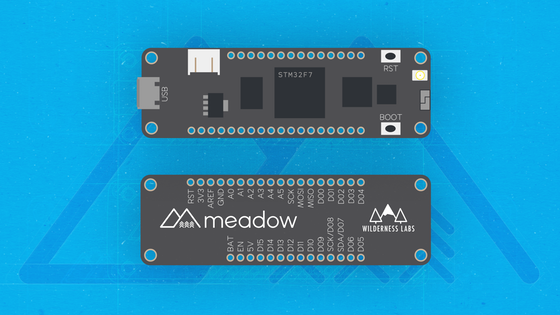Beta Boards are here, and 400% Funded!
about 6 years ago
– Sun, Nov 25, 2018 at 12:28:39 AM
Beta Boards are here, and 400% Funded Two great updates for you today. First, the final Meadow F7 Micro Debug PCBs came in. And Secondly, we hit 400% of our goal yesterday!!
On the funding side of the house; we’re putting together a stretch reward called the Hardware Hacker’s Workbench. It’ll include cool stuff like an awesome soldering station, professional oscilloscope, digital multimeter, high quality hand tools, and additional bulk components that will provide a complete professional IoT workbench and will cost somewhere in the neighborhood of $1k. It’ll be available if we hit ~$125k in funding. So make sure to tell anyone that might be interested in what we’re doing about the campaign!
Beta Debug Boards
Ok, let’s chat PCBs. Meadow boards have a 2.5 step process to manufacturing. The first step is to get Printed Circuit Boards (PCB) fabricated:

What you see here is a stack of Meadow F7 Micro boards in a 10-up panel (there are three panels for a total of 30 boards) that have additional debug IO for debugging the Meadow OS. Our beta backers will get a combination of debug and final form factor boards. This will allow us to gather additional debug information together when bugs and crashes occur during this early development phase.
The next step to this process is to take the components and the boards to the assembly house. They’ll go there on tuesday (assuming the last couple components come in on Monday), and will be done typically a week and a half to two weeks later.
Once these boards come back assembled, it’ll take us three to four weeks to stabilize the OS on the latest components and test them, then they will get shipped off to our beta backers!
Additional PCB Manufacturing Information
Many common PCBs are very simple; for instance, if you were to build a smart toaster/convection oven powered by Meadow, you’d need one or two boards (depending on your industrial design) that had a few peripherals like relays, a display, buttons, and camera and sensors connectors on them. For commodity boards like this, you’d be able to use nearly any default stack-up (PCB board specification for layers) available at a PCB house. Meadow is different, though. It has a number of incredibly precise electrical tolerance requirements because it carries high-speed signals, namely, USB and the memory lines. This requires us to use high quality suppliers.
For a prototype board like this RushPCB, based out of Silicon Valley (and I think Toronto) has served us incredibly well. They can usually turn a high quality PCB design around in 5 business days (faster for more money), though with the ordering process, engineering questions, and shipping, we typically count on 2 weeks.
At the same time we ordered these boards, we also ordered the components necessary to complete them (step 1.5). We have huge quantities of the “jelly bean” components, such as capacitors, resistors, etc. but because we have limited financial resources, we only order the more expensive components as we need them. So right now, we’re getting 30 of these assembled. There’s always a chance that whenever you get new boards made, there is a mistake in them that will require additional revisions, so we’re always trying to balance getting enough to use and not too many that will be wasted. In this case, we think that these will be the final debug boards that will go to beta pledges (and be used internally). But as you you can see, there are a limited amount.
These boards are in an array like this, because it makes the assembly process much more efficient (meaning faster, cheaper). Usually, you hand off your single PCB design to a PCB fabrication house and they will panelize it to your size specifications. For production scale runs, you typically want to panelize them to the largest size that your assembly house can handle.

For prototype assembly, we are fortunate to live in a region where good local assembly shops are an option. We typically use either Screaming Circuits (based out of Tualatin, just outside of Portland), or PCB Unlimited. Using a local shop saves us on component shipping costs and time.
The official turnaround time is 5 business days, but we almost always lose at least a day to engineering questions from the assembly house and will often be missing some small quantity of components.
Stay tuned for more updates on both the stretch reward and the lifecycle of these boards.


